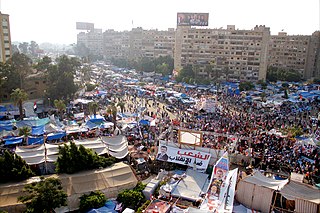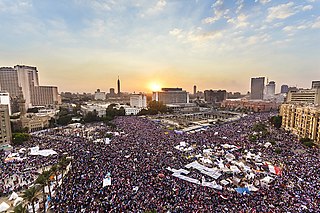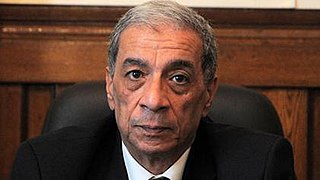Capital punishment is a legal penalty in Egypt. The state carried out at least 44 executions in 2016, at least 35 in 2017, and at least 43 in 2018, according to Amnesty International. The method of execution is hanging for civilian convictions, and by firing squad for convictions by commissioned military personnel at the time of duty.

Mohammed Badie is the eighth Supreme Guide of the Muslim Brotherhood.

The Egyptian Crisis was a period that started with the Egyptian revolution of 2011 and ended with the beginning of the presidency of Abdel Fattah el-Sisi in 2014. It was a tumultuous three years of political and social unrest, characterized by mass protests, a series of popular elections, deadly clashes, and military reinforcement. The events have had a lasting effect on the country's current course, its political system and its society.

The following is a chronological summary of the major events that occurred during the Egyptian Revolution of 2011, after Hosni Mubarak's resignation. Protests and riots led to the deaths of hundreds, injuries of thousands and the arrests of tens of thousands. Millions have mobilised the streets since the revolution.
The al‑Nour Party, or "Party of The Light", was one of the political parties created in Egypt after the 2011 Egyptian Revolution. It has an ultra-conservative, Islamist ideology, which believes in implementing strict Sharia law. It has been described as the political arm of the Salafi Call Society, and "by far the most prominent" of the several new Salafi parties in Egypt, which it has surpassed by virtue of its "long organizational and administrative experience" and "charismatic leaders". Its political aim is to establish a theocratic state on the lines of Wahhabism like in Saudi Arabia. Saudi Arabia was found to be the main financer of the party according to the public German television news service ARD.

Mohamed Mohamed Morsi Eissa Al-Ayyat was an Egyptian politician, engineer, and professor who was the fifth president of Egypt, from 2012 to 2013, when General Abdel Fattah el-Sisi removed him from office in a coup d'état after protests in June. An Islamist affiliated with the Muslim Brotherhood organization, Morsi led the Freedom and Justice Party from 2011 to 2012.
The Port Said Stadium riot was a riot which occurred at Port Said Stadium in Port Said, Egypt on 1 February 2012, following an Egyptian Premier League football match between Al Masry and Al Ahly. Seventy-four people were killed and more than 500 injured after thousands of Al Masry fans invaded the pitch following a 3–1 victory by their club. Al Ahly fans were attacked using clubs, stones, machetes, knives, bottles, and fireworks, trapping them inside the Al Ahly partition of the stadium. Many of the deaths were due to police refusal to open the stadium gates, trapping fans inside and causing a stampede. Civil unrest and clashes with police erupted in several major cities, such as Cairo, Alexandria, and Suez, in response to police's handling of the riot.

Hesham Mohamed Qandil is an Egyptian engineer and civil servant who was Prime Minister of Egypt from 2012 to 2013. Qandil was appointed as prime minister by President Mohamed Morsi on 24 July 2012 and sworn in on 2 August 2012. Qandil previously served as Minister of Water Resources and Irrigation from 2011 to 2012.

The cabinet of Egyptian Prime Minister Hesham Qandil was sworn in on 2 August 2012. Qandil was appointed by President Mohamed Morsi, following the resignation of military-named premier Kamal Ganzouri. The cabinet consists of 36 ministers. The composition of the government is mostly formed by technocrats, with five Freedom and Justice Party (FJP) members and one member each from the Al-Wasat and Renaissance parties.

The 2012–2013 Egyptian protests were part of the crisis in Egypt including the June 2013 protests, the July 2013 coup d'état, and part of the post-coup unrest. They saw varying opposition against three contiguous heads of state; namely, the Supreme Council of the Armed Forces (SCAF), Muslim Brotherhood, and the de facto ruling Egyptian Armed Forces.

The Anti-Coup Alliance is a coalition in Egypt formed to reverse the ouster of former president Mohamed Morsi. The coalition is made up of approximately 40 Islamist parties and groups.

The 2013 Egyptian coup d'etat or the Counter-revolution is an event that took place on 3 July 2013. Egyptian army chief General Abdel Fattah el-Sisi led a coalition to remove the democratically elected President of Egypt Mohamed Morsi from power and suspended the Egyptian constitution of 2012. The move came after the military's ultimatum for the government to "resolve its differences" with protesters during widespread national protests. The military arrested Morsi and Muslim Brotherhood leaders, and declared Chief Justice of the Supreme Constitutional Court Adly Mansour as the interim president of Egypt. The announcement was followed by demonstrations and clashes between supporters and opponents of the move throughout Egypt.

The 30 June protests occurred in Egypt on 30 June 2013, marking the one-year anniversary of Mohamed Morsi's inauguration as president. The events ended with the 2013 Egyptian coup d'état after mass protests across Egypt demanding the immediate resignation of the president. The rallies were partly a response to Tamarod, an ostensibly grassroots movement that launched a petition in April 2013, calling for Morsi and his government to step down. Tamarod claimed to have collected more than 22 million signatures for their petition by June 30, although this figure was not verified by independent sources. A counter-campaign in support of Morsi's presidency, named Tagarod, claimed to have collected 26 million signatures by the same date, but this figure was also unverified and not mentioned in media nearly as much as Tamarod's, with no reliable sources repeating it. The movements in opposition to Morsi culminated in the June 30 protests that occurred across the country. According to the Egyptian military, which calculated the number of protesters via helicopter scans of demonstration perimeters across the country, the June 30 protests had 32 million protesters, making them "the biggest protests in Egypt's history." However, independent observers raised concerns that the Egyptian government exaggerated the actual number of anti-Morsi protestors, with some research determining that only around one to two million people protested across the country against Morsi.

Protests against the 2013 Egyptian coup d'état erupted in July 2013. Immediately following the removal of President Mohamed Morsi by the Egyptian Armed Forces on 3 July 2013 amid demonstrations against Morsi's rule, many protesters amassed near the Rabia Al-Adawiya Mosque to call for Morsi's return to power and condemn the military, while others demonstrated in support of the military and interim government. Deadly clashes such as Rabaa massacre continued for several days, with three particularly bloody incidents being described by officials as "massacres" perpetrated by security forces. During the month of Ramadan, prime minister Hazem al-Beblawy threatened to disperse the ongoing Pro-Morsi sit-ins in Rabaa al-Adaweya square and al-Nahda square. The government crackdown of these protests occurred in a violent dispersal on 14 August 2013. In mid-August, the violence directed by the army towards the protesters escalated, with hundreds killed, and the government declaring a month-long nighttime curfew.

Hisham Muhammad Zaki Barakat was Prosecutor General of Egypt from 2013 to 2015. During his term as state prosecutor, he was responsible for thousands of controversial prosecutions, including several widely deemed politically motivated resulting in death sentences for hundreds of Muslim Brotherhood members and supporters of deposed Egyptian President Mohamed Morsi. He was assassinated in a car bombing on 29 June 2015.

Mohamed Ibrahim Moustafa, often referred to simply as Mohamed Ibrahim was the Minister of Interior of Egypt, from January 2013 until March 2015.

On 14 August 2013, the Egyptian police, under the command of then-Defense Minister Abdel Fattah el-Sisi, used lethal force to “disperse” two camps of protesters in Cairo: one at al-Nahda Square and a larger one at Rabaa al-Adawiya Square. The two sites had been occupied by supporters of President Mohamed Morsi, who had been removed from office by the military a little over a month earlier following mass protests against his rule. Initiatives to end the six-week sit-ins by peaceful means had failed, and the camps were cleared out within hours.

The Rabaa or Rabbi'ah sign - often stylized as R4BIA or less commonly as Rab3a, is a hand gesture and a sign that first appeared in late August 2013, thought to have originated from Turkey and used in social media and protest marches in Egypt. It is used by the Muslim Brotherhood and its supporters in Egypt in the wake of the overthrow of Mohamed Morsi, which occurred after anti-government protests calling for his removal. On July 9, 2014, a Brotherhood-affiliated organization declared August 14, the day when the sit-ins were dispersed, "World Rabia Day," in an attempt to garner support across numerous countries.
The raid on Kerdasa took place on September 19, 2013, in Kerdasa when Egyptian security forces stormed the town to cleanse it from alleged terrorist spots. The operation was in response to an earlier massacre on August 14 the same year, where protesters attacked a police station killing eleven security personnel shortly after the Egyptian security forces had launched a violent crackdown and massacre on two protest camps in Cairo where hundreds of supporters of ousted Egyptian president Mohamed Morsi were killed. The raid came a few days after a similar operation in Minya's town of Dalga, and was part of a larger crackdown by the interim government on armed supporters of deposed President Mohamed Morsi.
The 2014 Farafra ambush occurred on 19 July 2014 when unidentified gunmen ambushed a desert checkpoint in the Farafra Oasis Road in Egypt's New Valley Governorate. Twenty-two border guards were killed in the attack, which was one of the biggest since the July 2013 ouster of Egyptian president Mohamed Morsi and the second at the same checkpoint in less than three months.













